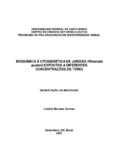| dc.creator | Correa, Lizelia Moraes | |
| dc.date.accessioned | 2009-03-09 | |
| dc.date.available | 2009-03-09 | |
| dc.date.issued | 2007-02-23 | |
| dc.identifier.citation | CORREA, Lizelia Moraes. Biochemistry and citogenetic of silver catfish (Rhamdia quelen) exposed to different thorium concentrations. 2007. 60 f. Dissertação (Mestrado em Ciências Biológicas) - Universidade Federal de Santa Maria, Santa Maria, 2007. | por |
| dc.identifier.uri | http://repositorio.ufsm.br/handle/1/11173 | |
| dc.description.abstract | The objective of this study was to evaluate the effect of thorium (Th) on the metabolism of silver catfish (Rhamdia quelen) through biochemical parameters from the muscle tissue (glycogen, glucose, lactate, protein and ammonia), lipidic peroxidation levels (TBARS), catalase (CAT) and glutathione-S-transferase (GST) in the hepatic and muscular tissues and cytogenetic parameters through the evaluation of nuclear abnormalities in blood cells. Silver catfish juveniles
(8.78 ± 0.10cm; 6.41 ± 0.17g) were exposed to different waterborne concentrations of ²³²Th (in μg.L-1): 33.6±8.7; 106.5±37.1; 191.6±19.0 and 758.4±150.4 for 15 days. The levels of muscle glycogen were significantly reduced in fish exposed to 106.5 μg.L-¹ Th, while glucose and protein
increased in those exposed to 758.4 μg.L-¹ Th. Lactate levels were higher in fish maintained at 191.6 μg. L-¹ Th and ammonia was higher in those exposed to 33.6, 106.5 and 191.6 μg.L-¹ Th. The lipidic peroxidation levels were diminished in the liver of silver catfish exposed to all tested
concentrations of Th. In the muscle lipidic peroxidation was higher in juveniles maintained at 106.5 μg.L-¹ Th and lower in those exposed to 191.6 and 758.4 μg.L-¹ Th. The CAT activity was higher in the hepatic tissue (but not muscle) of fish exposed to all tested concentrations of Th. The GST activity in the liver was lower in fish exposed to 33.6 and 106.5 μg.L-¹ Th, and in the muscular tissue of those maintained at 758.4 μg.L-1 Th. Silver catfish exposed to 106.5 μg.L-¹ presented a significant induction of micronuclei, but no alterations in other erythrocyte abnormalities were observed. These results suggest that exposure to waterborne Th induces changes in the metabolic state, increase of lipidic peroxidation in the liver, some alterations of CAT and GST, and DNA damage. | eng |
| dc.format | application/pdf | por |
| dc.language | por | por |
| dc.publisher | Universidade Federal de Santa Maria | por |
| dc.rights | Acesso Aberto | por |
| dc.subject | Peixes | por |
| dc.subject | Estresse oxidativo | por |
| dc.subject | Micronúcleos | por |
| dc.subject | Ecotoxicologia | por |
| dc.subject | Fish | eng |
| dc.subject | Stress oxidative | eng |
| dc.subject | Micronuclei | eng |
| dc.subject | Ecotoxicology | eng |
| dc.title | Bioquímica e citogenética de jundias (Rhamdia quelen) expostos a diferentes concentrações de tório | por |
| dc.title.alternative | Biochemistry and citogenetic of silver catfish
(Rhamdia quelen) exposed to different thorium
concentrations | eng |
| dc.type | Dissertação | por |
| dc.description.resumo | O objetivo deste estudo foi avaliar o efeito de tório (Th) sobre parâmetros metabólicos (glicogênio, glicose, lactato, proteína e amônia), em tecido muscular de jundiás (Rhandia
quelen), níveis de lipoperoxidação (TBARS), catalase (CAT) e glutationa-S-transferase(GST) nos tecidos hepático e muscular e parâmetros citogenéticos através da avaliação de
anormalidades nucleares em células sanguíneas. Juvenis de jundiás (8,78±0,10cm; 6,41± 0,17g) foram expostos a diferentes concentrações de ²³²Th 33,6±8,7; 106,5±37,1; 191,6±19,0 e 758,4±150,4 em μg. L-¹ (três repetições por tratamento) por 15 dias. Os níveis de glicogênio
muscular diminuíram significativamente a 106,5 μg. L-¹ Th. Glicose e proteína aumentaram na 758,4 μg. L-¹ Th. Os níveis de lactato apresentaram-se elevados em 106,5 μg. L-¹ Th. A amônia aumentou a 33,6; 106,5 e 191,6 μg.L-¹ Th. Os níveis de peroxidação lipídica diminuíram no fígado dos jundiás expostos a todas as concentrações de Th testadas. No músculo esquelético aumentaram a 106,5 μg. L-¹Th e diminuíram a 191,6 e 758,4 μg.L-¹ Th. A atividade da CAT no
tecido hepático apresentou aumento em todas as concentrações testadas de Th. Nenhuma alteração foi observada no tecido muscular. A GST diminui no fígado a 33,6 e 106,5 μg.L-¹Th. No tecido muscular diminui a 758,4 μg.L-1 Th. Jundiás expostos a 106,5 μg. L-¹ apresentaram
maior indução de micronúcleos. Não foi observadas alterações para outras anormalidades nucleares eritrocíticas. Os resultados obtidos sugerem mudanças nos intermediários
metabólitos devido ao estresse provocado pelo Th, aumento da lipoperoxidação no fígado, sendo observado níveis variados no músculo esquelético, alterações das enzimas CAT e GST
além de danos no DNA dos peixes expostos ao Th, comparando aos grupos controles. | por |
| dc.contributor.advisor1 | Baldisserotto, Bernardo | |
| dc.contributor.advisor1Lattes | http://lattes.cnpq.br/1036046601275319 | por |
| dc.contributor.referee1 | Gomes, Levy de Carvalho | |
| dc.contributor.referee1Lattes | http://lattes.cnpq.br/3105720686893127 | por |
| dc.contributor.referee2 | Loro, Vania Lucia | |
| dc.contributor.referee2Lattes | http://lattes.cnpq.br/6392817606416780 | por |
| dc.creator.Lattes | http://lattes.cnpq.br/2578526522701749 | por |
| dc.publisher.country | BR | por |
| dc.publisher.department | Bioquímica | por |
| dc.publisher.initials | UFSM | por |
| dc.publisher.program | Programa de Pós-Graduação em Ciências Biológicas: Bioquímica Toxicológica | por |
| dc.subject.cnpq | CNPQ::CIENCIAS BIOLOGICAS::BIOQUIMICA | por |


